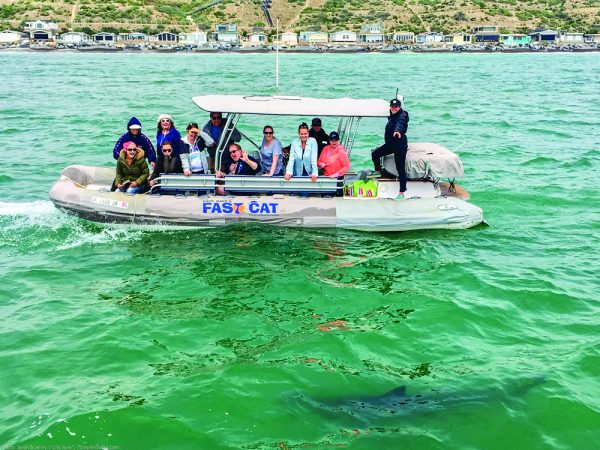Experts Say We’re not on the Menu
By Rita Robinson, Special to the Independent

Even though there are more great white sharks in the ocean alongside an increasing number of ocean-goers, experts say precaution, not panic, is required.
The number of white sharks is rising because they’re protected as is their food source, largely seals and sea lions.
“They’re not hunting us. We’re not on the menu,” said Ralph Collier, who founded the Shark Research Committee in Chatsworth 55 years ago to document Pacific Coast shark attacks for the Smithsonian Institution.
Collier recently released a report that shows an exponential increase in shark attacks. But, he states, “I never say shark attacks are on the rise. That’s the media.”
According to Collier’s report, in the first 18 years of this century, there have been 103 documented shark attacks along the West Coast. That nearly doubled the number, 108, that occurred in the 100 years from 1900 to 1999. Last year alone, there were nine, and that almost doubled those reported in 2016.
“So far this year, there have been none,” said Collier. “There’s no pattern.”
Sharks are simply investigating, he said, and usually find human fare unfamiliar and unappetizing. But, he points out, data on his website shows that recent attacks on humans, some within 100 yards of the shore, were all made by adult white sharks over 15-feet long and weighing 2,000 pounds or more.
Reversing a historical pattern of eradicating predators, California voters decided in 1994 to protect white sharks through bans on commercial, sport and gill-net fishing. The gill-net ban further protected pinnipeds, seals and sea lions, along with dolphins, initially safeguarded by the federal 1973 Endangered Species Act.
“They’re all predators we’ve worked hard to bring back and that’s exactly what they’re doing,” said Chris Lowe, Ph.D., director of the Shark Lab at Cal-State University, Long Beach. The natural balance is back, evidence that the ocean is healthier, he said. “We need to learn to live with them.”
While Collier says adult sharks are coming closer to shore, Lowe says they’re keeping their distance.
There are thousands of pinnipeds at rookeries on San Nicholas and San Miguel islands 60 miles off the Southern California coast, Lowe said. “If you were a shark, where would you go?”
With more than 2,500 paddles since 2010, Laguna Beach resident Rich German, an avid paddleboarder and videographer, said he’s never seen a white shark in Laguna waters. On the other hand, Mark Girardeau, a wildlife photographer from Huntington Beach, sees dozens of white sharks, particularly in the spring, within yards of the shoreline at Capistrano Beach in Dana Point.
Jeremy Frimond, Laguna Beach marine protection officer who studied white sharks off the coast of South Africa for three years, confirms German’s report.
“They’re not cold-blooded killers,” Frimond said, referring to what he calls a shark’s disinterest in people. The local coastline can’t sustain an adult white shark population, he said. “Rookeries with thousands of seals and sea lions won’t get established here because of the human coastal development,” he said.
Compared to the number of people in the water, the number of attacks have actually declined, Lowe added. “If you look at per capita, the numbers have gone way down,” he said.
Even if people are just a taste-test, one bite could render the recipient toast. The larger cast of saw-toothed ocean characters is known to leave a memorable mark.
“I’ve been back in the ocean, but I haven’t been back there,” said Maria Korcsmaros, a triathlete from Corona, Calif. Korcsmaros was severely serrated by a teenage great white two years ago inside the quarter-mile buoy at Big Corona beach in Corona del Mar.
She was training for a triathlon and swimming by herself. The water was murky, she said. The shark spit her out but left three broken ribs and a punctured liver.
World champion surfer Ian Cairns, a Laguna Beach resident, likes the feeling of surfing in the wild with the young sharks. But one adult shark close to shore is one too many, said the father of twin teenage surfers.
“I don’t want to be an alarmist,” he said. “I’ve been surfing at San Onofre with my kids and there are juvenile sharks in the water with us. They’re kind of cute when they’re little, but they’re not cool when they grow up.”
Cairns is supporting a detection device called the Clever Buoy. It texts a message to lifeguards when sonar on the ocean floor detects a shark. Plans are to pilot the device at Corona del Mar.
As for Korcsmaros, she was back in the water three months after her attack, completing eight triathlons since. She also joined the Bite Club, formed by a group of shark-attack survivors across Australia.
Lowe agrees that one shark bite can ruin a life. “So can one bad surfing accident,” he said. “Does that mean we’re going to build breakwaters all along the coast to stop the waves?”
Cairns dismisses that risk comparison as illogical, saying waves are inherent to surfing, sharks are not.
“No one minds getting injured surfing; that happens,” Cairns said. “But when there’s sharks out there in an urban environment, that’s unusual and we need to know about it.” If a mountain lion was known to be within yards of a trail, hikers would cancel plans, he said.
Collier’s advice for ocean-goers:
- Don’t go into the ocean alone, no matter what the activity, especially if the water is murky. Sharks can’t differentiate between a person and a sea lion in cloudy water.
- Don’t wear jewelry, i.e., ankle bracelets. Sharks are attracted by shiny objects, like the sun catching the silvery scales of a fish.
- Wear a single-color suit. Anything out of the ordinary, like a wildly patterned bathing suit or board shorts, they’re going to investigate to see if it’s food.





Sciemce. Again..
Arrested Development.
One attack is too many. Would if it was your child? End the ban on Great Whites and Seals. The friends of the sea lions have damaged the basic ecology of predator / prey.. More attacks are coming, it’s just a matter of time.
Greet information. Thank you for contacting me
Ian Cairns… The Ocean IS NOT an Urban Environment, even along the coastline. The Ocean… every bit of it, IS THE WHITE SHARK’S NATURAL HABITAT/DOMAIN, not ours. Human Beings enter at their own risk!!!
[…] are there,” Spector said, of sharks, which have been spotted in increasing number off local shorelines. “But I’ve never had an […]